Primula Veris (Cowslip Primrose)
Hello! We continue to talk about medicinal plants that grow in the territory of Ukraine. Today you will learn about the Primula Veris (Cowslip Primrose). Read about other medicinal plants of Ukraine by following this link. We hope you enjoy it!
Primula Veris (Cowslip Primrose)
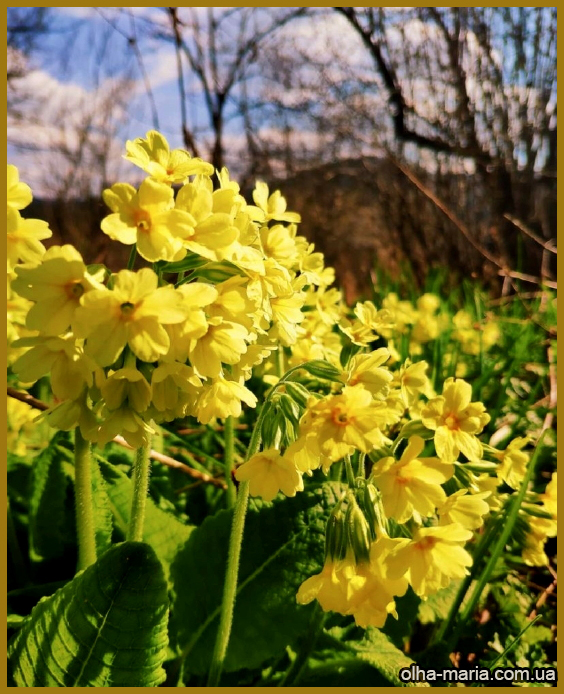
Botanical description
Distribution
Legends and beliefs
Pharmacological properties
Medical application
Culinary use
Growing in the backyard
Harvesting and storing
Primula veris, the cowslip, common cowslip, or cowslip primrose (syn. Primula officinalis Hill)
Perennial herbaceous plant of the primrose family.
In spring, when the air is filled with the scents of thyme and bird cherry, look for the mysterious golden keys of spring. According to legend, those who find them will discover all the treasures of the earth. The path to these magical keys can be indicated by the flowers of the spring primrose, resembling a cluster of golden keys.
Botanical description of the primula veris
Medicinal Herb Yellow Cowslip Primrose Primula veris – this is a perennial herbaceous plant, reaching a height of 5-30 cm, with a rosette of basal leaves measuring 5-20 cm in length. The leaves, which often lie close to the ground, have an egg-shaped or lanceolate-crescent shape. They appear wrinkled, with a wavy serrated margin. The leaves narrow down to a narrow-winged petiole at the bottom.
Between the rosette of leaves, one or several leafless flower stalks grow from the rhizome. The flower stalk, the only part of the plant that protrudes and can extend up to 30 cm or even higher, bears 8-12 bright yellow attractive flowers at its apex. The flowers are arranged in a unilateral drooping umbel with a five-toothed calyx and a five-petaled tubular corolla. The flowers have five stamens, each with orange spots. The flowers resemble a tilted bunch of golden keys, standing out beautifully among the spring grass.
The root of the medicinal primrose is very short, dark yellow or brownish in color, vertical, with a bunch of thin roots measuring 1 mm in diameter and up to seven millimeters in length.
The medicinal primrose blooms in April-June, emitting a pleasant fragrance. The fruit is an ovoid brown capsule with a large quantity of flattened seeds. The fruits ripen in June-July.
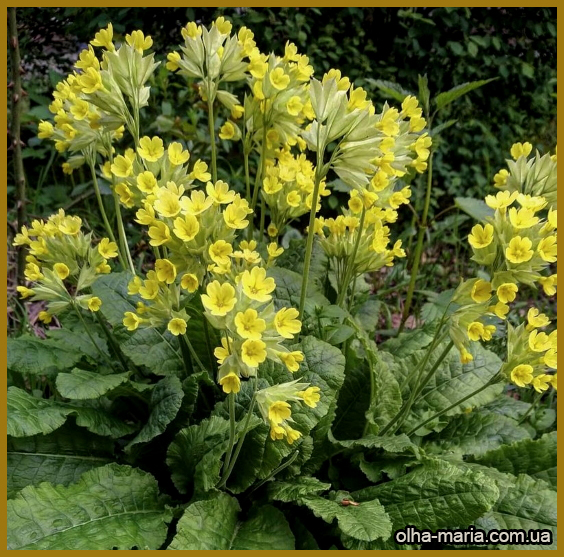
Первоцвіт занесений до Червоної книги. Ця цінна рослина має широке практичне використання: лікарська, вітамінозна, харчова, медоносна, фарбувальна (трава і квіти дають буро-оливкову фарбу), декоративна, використовуються також у гомеопатії та ветеринарії.
Distribution of the primula veris in Ukraine
The Primula veris (cowslip) is widespread in Ukraine in meadows, forested and forest-steppe slopes, and along roadsides, more commonly on the Right Bank and in Crimea. Regions involved in raw material harvesting include Volyn, Rivne, Zhytomyr, Khmelnytskyi, Vinnytsia, Kyiv, Poltava, Chernihiv, Sumy, and Kharkiv regions.
The Primula veris is also found in Asia, European countries, and North America. In European countries, the medicinal spring primrose is cultivated as a salad plant. In England, the primrose is highly valued even more than sorrel.
Legends and beliefs about the primula veris
According to ancient Greek legend, the goddess of spring, Freya, had an extraordinarily beautiful multicolored necklace of the rainbow. In that necklace, golden keys hung, which, when the goddess leaned down, touched the ground and opened it for warm days. Then the earth bloomed, revealing its treasures. Where the golden keys of the rainbow touched the ground, clusters of tiny golden keys – the primrose flower – grew, indicating where to search for the mysterious keys of spring.
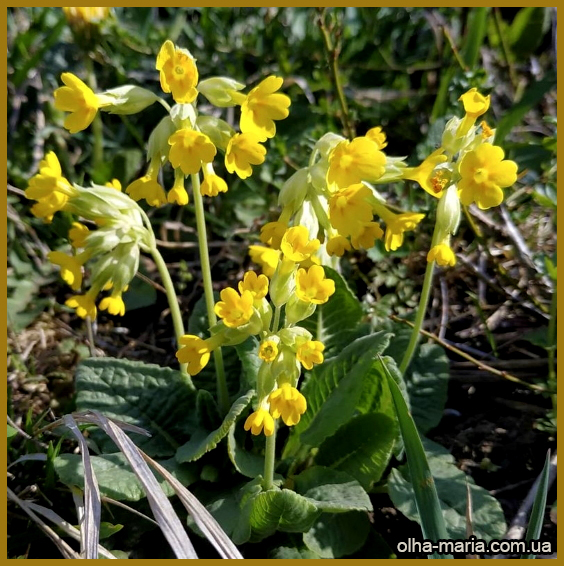
In other cultures, there were also many different legends and beliefs associated with the primrose. Germans believed that a girl who first found the primrose on Easter holidays would get married within the year. In England, there was a belief that bell-shaped drooping primrose flowers served as a refuge for mythical tiny fairies and angels during storms.
It was also believed that primrose herb possessed magical power, and priests brewed love potions from it. In the 17th-18th centuries, the primrose was one of the favorite garden flowers. As a result, several hybrid garden forms of the cowslip primrose were later developed.
Pharmacological properties of the cowslip primrose
The cowslip primrose) belongs to valuable vitamin plants. It contains a significant amount of vitamins A and C, allowing for a quick replenishment of these vitamins in the human body. In the primrose, the content of ascorbic acid is much higher than in onions, radishes, and parsley. Two or three leaves of the cowslip primrose satisfy the daily needs of an adult’s body for ascorbic acid (vitamin C) and carotene (vitamin A). Saponins are also found in the leaves, and in the flowers, there are saponins and flavonoids.
The pharmacological properties of the roots and above-ground parts of the cowslip primrose (Primula officinalis Hill) are mainly associated with saponins. In addition, the primrose contains essential oil and glycosides: primulaverin, primulogenin, primverin, which belong to terpene compounds.
Medical application of primula veris (cowslip primrose)
The medicinal properties of cowslip primrose were known to ancient Greeks. They believed that primrose was a healing flower of Olympus and contained remedies for all ailments.
All parts of the Primula veris (cowslip) — flowers, leaves, and roots — possess medicinal properties. This plant has spasmolytic, diuretic, and expectorant effects. In scientific medicine, the leaves of primrose are used as a vitamin supplement to prepare concentrates of vitamin C, recommended for the treatment of hypo- and avitaminosis.
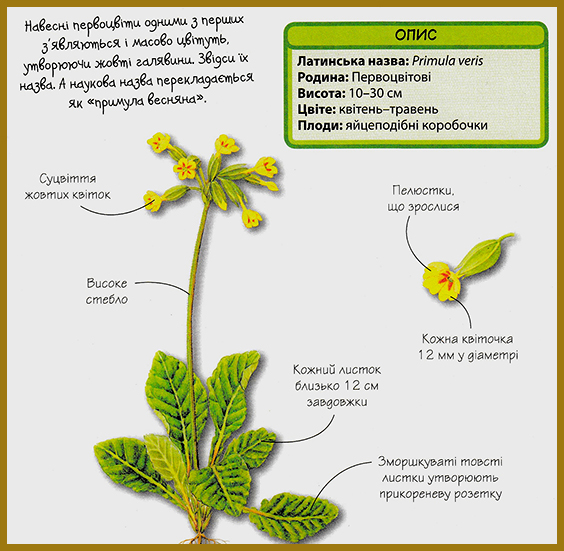
The roots are used as an expectorant in respiratory diseases, especially in bronchitis, pneumonia, whooping cough, asthma, and as a diuretic and diaphoretic agent during the flu.
Cowslip primrose is used in traditional medicine and herbal remedies due to its various health benefits. The plant’s medicinal properties are attributed to its rich content of bioactive compounds, including saponins, essential oil, and glycosides. Here are some of the medical applications of primrose:
- Vitamin Boost: Primrose is a valuable source of vitamins A and C. The high content of ascorbic acid (vitamin C) in primrose helps quickly replenish the body’s deficiency of this vitamin.
- Respiratory Health: The saponins present in primrose contribute to its expectorant properties, making it useful in addressing respiratory issues. It may help relieve symptoms of coughs and congestion.
- Anti-inflammatory: The plant’s bioactive compounds, including flavonoids, contribute to its anti-inflammatory properties. This makes primrose a potential remedy for inflammatory conditions.
- Saponins: Saponins found in both the leaves and flowers of primrose are known for their potential benefits in reducing cholesterol levels and supporting heart health.
- Carotene Content: The carotene (vitamin A) content in primrose supports eye health and overall immune function.
- Essential Oil: The presence of essential oil in primrose adds to its therapeutic properties, potentially offering benefits such as relaxation and stress relief.
It’s important to note that while primrose has traditional uses in herbal medicine, individuals should consult with healthcare professionals before incorporating it into their treatment, especially if they have pre-existing health conditions or are taking medications.
Decoction from cowslip primrose roots: take one tablespoon of chopped roots per cup of boiling water, boil for 7-10 minutes. Infuse for 10 minutes. Drink two to three times a day, half a cup each time, 30 minutes before meals. The decoction of Primula veris roots is also used as a sedative for joint pain, chronic constipation, and all diseases of the urinary and renal organs.
In case of fever, colds associated with throat and lung diseases, Primula veris is used as a tea. Take one tablespoon of leaves and flowers per cup of boiling water, infuse for 10 minutes. Drink one to two cups a day. Also used for nasal irrigation during rhinitis; for insomnia and headaches (migraines), increased nervous excitability, and accelerated heart rate. It is also applied for gout and to purify the blood in case of boils, ulcers, and rashes on the body.
Additionally, the powder of crushed primrose leaves is taken for lethargy, loss of appetite, rapid fatigue, exhaustion of the body due to chronic illnesses, injuries, surgical interventions, and for gum diseases.
Powder from Primula veris leaves: dried in the shade, spring primrose leaves are slightly dried in the oven at a low temperature, ground in a mortar, and sifted. Store in closed jars or metal boxes. Used for seasoning soups and making beverages.
Attention! It is known from practice that cowslip primrose can cause an allergic reaction in some individuals.
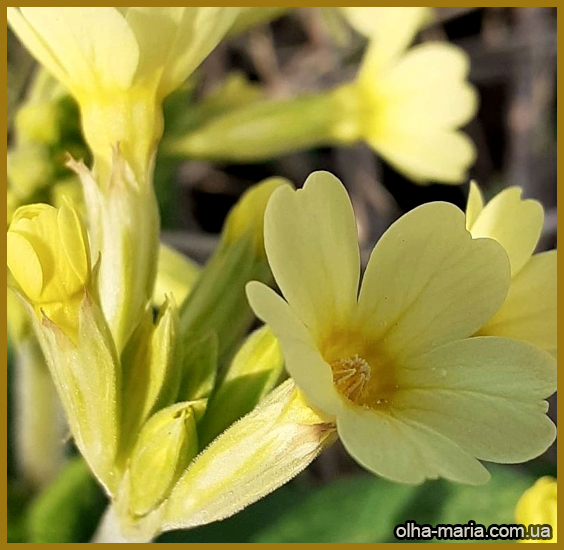
Culinary use of primula veris (cowslip primrose)
There are no contraindications for the use of medicinal cowslip primrose.
Medicinal Primula veris (cowslip) is an excellent edible plant. Young leaves are consumed when there is still no garden greenery. Young primrose leaves are used for making salads, soups, and borscht.
Primula veris salad: 100 g of leaves, 80 g of boiled beets, 25 g of green onions, 20 g of sour cream, salt to taste. Refrigerate for 10 minutes before serving.
Very useful salads in early spring from the leaves of such plants: 3-4 leaves of primula veris (cowslip), coltsfoot, medicinal mint, young stems of common sorrel. Wash, chop, add a tablespoon of sunflower oil or sour cream, and consume two to three times a week before lunch.
Soup with primula veris and chicken: 160 g of cowslip primrose leaves, 40 g of barley, 20 g of carrots, 30 g of onions, 20 g of fat, spices to taste. First, cook the chicken and barley, then add chopped greens, spices, sautéed carrots, and onions. Cook until ready.
Seasoning for meat with cowslip primrose: 10 g of dry primrose leaf powder, 20 g of spicy tomato sauce, one tablespoon of water. Mix the powder with water, add tomato sauce, stir, and leave for two hours.
Growing primula veris (cowslip) in the backyard is quite simple
Primula veris is easy to cultivate in your backyard. If you collect seeds in June-July and sow them in the open ground in the fall, abundant seedlings will emerge the following spring. With sufficient moisture, the seedlings reach the size of mature plants during the summer, making it practical to transplant them in the fall.
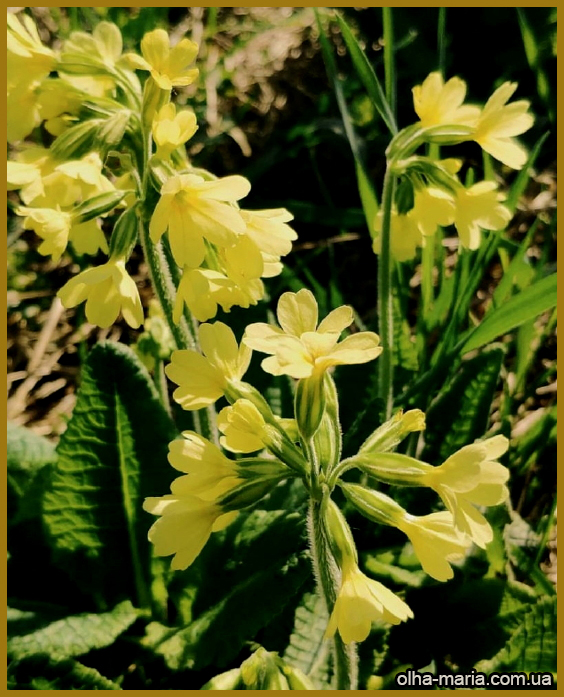
Harvesting and storing cowslip primrose
Primula veris (cowslip primrose) is gathered during its flowering period, mainly from the blossoms. The collection process involves air-drying or using well-ventilated indoor spaces. The roots, on the other hand, are harvested in the fall and spring.
For the roots:
- Dig up the roots during the fall and spring seasons.
- Clean the harvested roots by washing them and removing any remaining leaves or stems.
- Allow the roots to air-dry and further dry them in a dryer at temperatures ranging from 40 to 50 °C.
This method ensures proper preservation for later use.
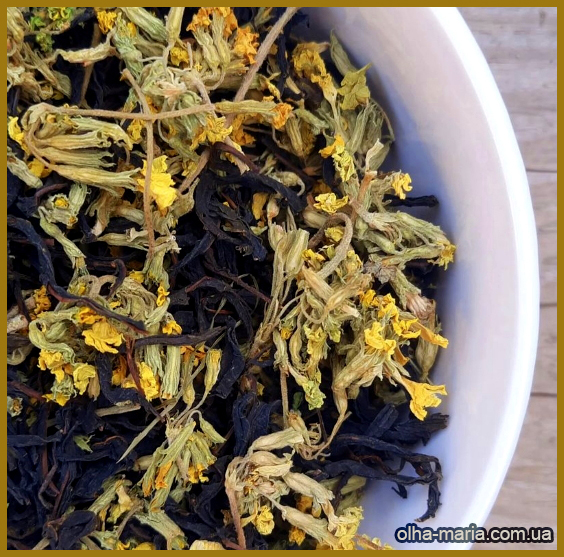
Dried raw material has a light brown color and a distinctive honey scent. In taste, it is initially sweet, followed by a slightly bitter undertone.
The shelf life of primula veris raw material is 2 years.
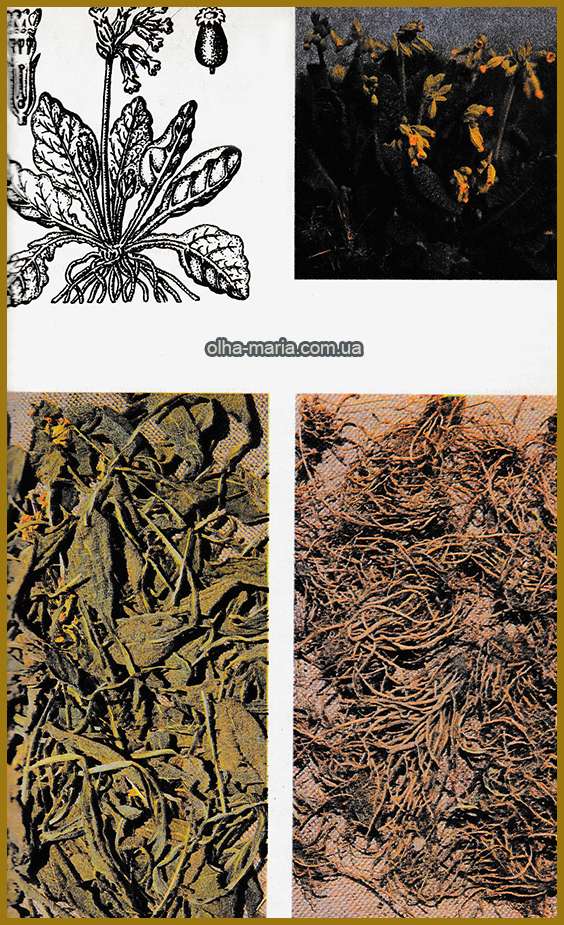
Used literature:
- Perevozchenko I. I. and others. Seek a doctor in nature. – Kyiv: Urozhay, 2002. – 216 p.: ill.
- Karkhut V. V. Medicines around us. – Kyiv: Zdorov’ya, 2001. – 232 p.: ill.
- Pimukov D. P., Akhtardzhiyev Kh. Z. Pharmacy of living nature. – Kyiv: Urozhay, 1991. – 304 p.
- Tovstukha Ye. S. Phytotherapy. – Kyiv: Oriyani, 2000. – 432 p.
- Mamchur F. I. Healing herbs. – Kyiv: Zdorov’ya, 1993. – 208 p.
- Dyslevy V. Encyclopedia of useful and dangerous plants for children. – Kyiv: FOP “Munin G. B.”, 2016. – 240 p.: ill.
- Mamchur F. I., Gladun Ya. D. Medicinal plants in the backyard. – Kyiv: Urozhay, 1993. – 128 p.
You can leave your feedback in the comments under this article. Thank you!
Learn more! And don’t forget to subscribe to our channels:
Or click on the link to go to the HOME PAGE
It’s rare to find such warmth and wisdom coexisting so naturally in writing — truly a gift.